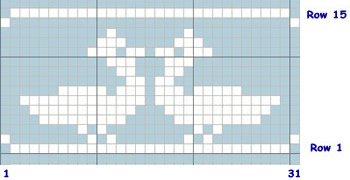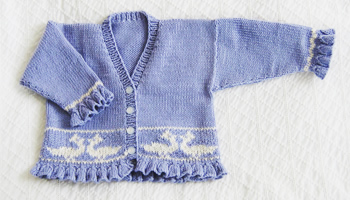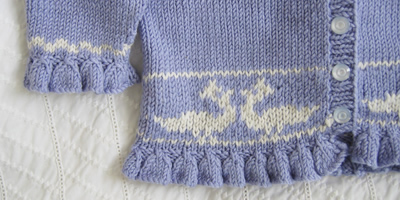Instructions:
The body of the cardigan is knitted in one piece. There are options for
a plain welt as well as the frilled version - perhaps to better suit a
boy.
Frilled welt:
Cast on 308 sts.
1st row: *
P2, k7; repeat from *to last 2 sts;
p2.
2nd row: K2, *p7,
k2; repeat from *to end.
3rd row: *P2,
slip1, k1, pass the slipped st over, k3, k2tog; repeat from *to
last 2 sts; p2.
4th row: K2, *p5,
k2; repeat from *to end.
5th row: *P2,
slip1, k1, pass the slipped st over, k1, k2tog; repeat from *to
last 2 sts; p2.
6th row: K2, *p3,
k2; repeat from *to end.
7th row: *P2,
slip2 together, k1, pass two slipped st over together; repeat from *to
last 2 sts; p2.
8th row: P4, *m1,
p5; repeat from *to end. [124 sts]
[m1 = make one by picking up a loop between the sts and purling into the
back of it.]
Alternative plain ribbed welt:
Cast on 124 sts and work 6 rows in k1, p1 rib.
9th row: K31, place marker; k62,
place marker; k31.
Duckling border:
Continue in stocking stitch.
Work the 15 rows from the chart, working left to right on the wrong side
rows, and working right to left on the right side rows.
Starting with wrong side facing, set the 31 stitch pattern across the
row as follows:
[Editor's note: Weave
the unused colour in across the back as you knit. This tends to make the
knitting rather tight so make sure you knit loosely - or - use needles
one size larger while you knit these 15 rows.].
Row 1: *p1
in blue, p29 in white, p1 in blue*; p0; repeat
from * to *
twice; p0; repeat from * to *.

Row 15: as row 1.
Break contrast yarn.
Next row: (right side facing) Knit
in main shade.
Next row: (wrong side facing) Purl
in main shade.
Continue with main shade only stocking stitch until work measures 6 inches,
including the frill, ending with a purl row and right side facing for
next row.
[Editor's note: This
is approximately 22 rows in main shade after you have finished the pattern
rows.]
Divide for fronts and back:
Next row: (right side facing)
S1, k1, psso, (also known as ssk), knit 29st; turn. Continue on these
30 sts to make the right front, leaving remaining sts on a stitch holder.
Next row: Purl.
Next row: Knit
Next row: Purl.
Next row: S1, k1, psso, (also known
as ssk), knit to end.
Repeat the last 4 rows, decreasing at front edge only until 21 sts remain.
Continue without shaping until armhole edge measures 5 inches, ending
with a purl row.
[Editor's note: This
is approximately 40 rows for the armhole.]
Break yarn, leaving sts on a holder for grafting.
Left front:
With right side facing, slip 31sts from the holder for the left front
on to a working needle, rejoin the yarn at the armhole edge, and knit
1 row. Leave the centre 62 sts on the holder to pick up later for the
back.
Next row: (wrong side facing) P2tog,
purl 29; turn.
Next row: Knit.
Next row: Purl
Next row: Knit.
Next row: P2tog, purl to end.
Repeat the last 4 rows, decreasing at front edge only until 21 sts remain.
Complete to match the right front, ending with a knit row.
Back:
With right side facing, rejoin the yarn to the remaining 62 sts on
the holder, and knit across all sts.
Work straight in stocking stitch until back matches fronts at armhole
edge, ending with a purl row.
Next row: K21, cast off 20, k21.
Break yarn, leaving two lots of shoulder sts on a holder for grafting.
Join shoulders.
Graft front and back shoulder sts together.
Sleeves (both alike):
Cast on 83 sts, and work frilled welt as follows:
1st row: *
P2, k7; repeat from *to last 2 sts;
p2.
2nd row: K2, *p7,
k2; repeat from *to end.
3rd row: *P2,
slip1, k1, pass the slipped st over, k3, k2tog; repeat from *to
last 2 sts; p2.
4th row: K2, *p5,
k2; repeat from *to end.
5th row: *P2,
slip1, k1, pass the slipped st over, k1, k2tog; repeat from *to
last 2 sts; p2.
6th row: K2, *p3,
k2; repeat from *to end.
7th row: *P2,
slip2 together, k1, pass two slipped st over together; repeat from *to
last 2 sts; p2.
8th row: P1, *m1,
p3; repeat from *to last stitch, m1, p1.
[39 sts]
[m1 = make one by picking up a loop between the sts and purling into the
back of it.]
Alternative plain ribbed welt:
Cast on 39 sts and work 6 rows in k1, p1 rib.
Now join in contrast and work 3 rows as follows.
9th row: K1 in main shade, k2 contrast;
* k2 main shade; k2 contrast; repeat from
* to end, (stringing the unused yarns as
before across the back of the work). Break main shade yarn.
10th row: Purl across row in contrast.
11th row: Rejoin main shade and work
as row 9. Break contrast yarn.
12th row: Purl across row in main
shade.
Continuing in main shade only, increase one stitch at each end of the
next and every following 4th row, until there are 61sts. Work straight
until sleeve is 8 inches long (including the frill), or to required length.
Cast off loosely, using one size larger needle.
Work second sleeve the same.
Button border:
With right side facing, using the No 9 (3½mm) circular needle
as before, commencing at the right front above the frill, pick up and
knit 29 sts evenly along straight edge, 29 sts evenly along shaped edge,
20 sts across back neck, then 29 sts evenly along shaped edge of left
front, and finally 29 sts evenly along straight edge of left front, ending
at top of frill. [136 stitches].
[Editor's note: My
method for picking up sts evenly is to pick up 2 sts for every 3 row ends.
I use a double pointed needle and slip it into all the alternate row ends
- the ones that tend to stick out more as little bumps. Then using my
working needle, I knit into 2 bumps from the dpn and then pick up an extra
stitch in between the bumps.
The number of stitches you pick up will depend on how many rows you knitted in the body, so if it's not quite 136 it does not matter; you can still follow the instructions below provided you end up with an even number of stitches .]
Next row: Slip the first stitch;*
k1; p1; repeat from * to last st;
k1.
Next row: Slip the first stitch; k1,
p1, * k2tog; yarn over needle; p1; (k1, p1)
3 times repeat from * twice more, then k2tog;
yarn over needle; p1, to make the 4th buttonhole.
Continue in rib as set to end of row.
Next row: Slip the first stitch;*
k1; p1; repeat from * to last st;
k1.
Work one more row in rib, then cast off loosely in rib, using a larger
size needle if required.
Making up:
Fold sleeves in half lengthwise, then sew into armholes placing fold at
grafted shoulder seam. Join sleeve seams.
Sew in all ends.
Press lightly with a damp cloth.
Sew 4 buttons in position to match buttonholes.
|



